Research on Arc Erosion Resistance of High-Entropy Alloy-Modified Aluminum Alloy Armature Based on Molecular Dynamics Simulation
Abstract
1. Introduction
2. Microscopic Model and Simulation Process of Modified Armature Subjected to Arc Erosion
2.1. Establishing the Model for Arc Erosion of High-Entropy Alloy-Modified Aluminum Alloy Armature
2.2. Potential Function Setup
2.3. Simulation Condition Settings
3. Material Surface Temperature and Thermodynamic Parameters Change Rule
4. Evolution of the Microstructure of the Material
4.1. Depth of Bombardment Intrusion
4.2. Structural Changes during Bombardment
4.3. Degree of Surface Damage to the Aluminum Matrix
5. Conclusions
Author Contributions
Funding
Institutional Review Board Statement
Informed Consent Statement
Data Availability Statement
Conflicts of Interest
References
- Mcnab, I.R. Large-scale pulsed power opportunities and challenges. IEEE Trans. Plasma Sci. 2014, 42, 1118–1127. [Google Scholar] [CrossRef]
- Ma, W.M.; Lu, J.Y. Research Progress and Challenges of Electromagnetic Launch Technology. Trans. China Electrotech. Soc. 2023, 38, 3943–3959. [Google Scholar]
- Lu, J.Y.; Ma, W.M. Lectromagnetic Rail Launch Theory and Technology; Science Press: Beijing, China, 2020. [Google Scholar]
- Fair, H.D. The science and technology of electric launch. IEEE Trans. Magn. 2001, 37, 25–32. [Google Scholar] [CrossRef]
- Sanogo, S.; Messine, F.; Henaux, C.; Vilamot, R. Topology optimization for magnetic circuits dedicated to electric propulsion. IEEE Trans. Magn. 2014, 50, 7401013. [Google Scholar] [CrossRef]
- Meger, R.A.; Cairns, R.L.; Douglass, S.R.; Huhman, B.; Neri, J.M.; Carney, C.J.; Jones, H.N.; Cooper, K.; Feng, J.; Brintlinger, T.H.; et al. EM gun bore life experiments at naval research laboratory. IEEE Trans. Plasma Sci. 2013, 41, 1533–1537. [Google Scholar] [CrossRef]
- Li, F.; Liu, J.X.; Huang, X.; Zhang, G. Porous Ultra-High Temperature Ceramics: Preparation, Structure and Properties. J. Chin. Ceram. Soc. 2018, 46, 669–1684. [Google Scholar]
- Zhou, H.T.; Xiong, X.Y.; Luo, F.; Luo, B.-W.; Liu, D.-B.; Shen, C.-M. Graphene enforced copper matrix composites fabricated by in-situ deposition technique. Acta Phys. Sin. 2021, 70, 086201. [Google Scholar] [CrossRef]
- Wang, L.; Cui, Y.; Li, B.; Yang, S.; Li, R.; Liu, Z.; Vajtai, R.; Fei, W. High apparent strengthening efficiency for reduced graphene oxide in copper matrix composites produced by molecule-lever mixing and high-shear mixing. Rsc. Adv. 2015, 5, 51193–51200. [Google Scholar] [CrossRef]
- Song, H.Y.; Zha, X.W. Mechanical properties of Ni-Coated single graphene sheet and their embedded aluminum matrix composites. Commun. Theor. Phys. 2010, 54, 143–147. [Google Scholar]
- Xing, K.; Xu, H.B.; Yan, C.; Chen, G.; Chen, M.; Zhu, Y. Research Progress on Interface Properties of Carbon Fiber Reinforced High Performance Thermoplastics Composite. Compos. Sci. Eng. 2019, 110–115. [Google Scholar]
- Zhang, Y.; Wang, X.Y.; Yu, J.; Cao, W.; Feng, P.; Jiao, S. Advances in Surface Modification of Molybdenum and Molybdenum Alloys at Elevated Temperature. Mater. Rep. 2017, 31, 83–87. [Google Scholar]
- Zhang, W.R.; Peter, K.L.; Zhang, Y. Science and technology in high-entropy alloys. Sci. China Mater. 2018, 61, 2–22. [Google Scholar] [CrossRef]
- Zhang, G.J.; Tian, Q.W.; Yin, K.X.; Niu, S.Q.; Wu, M.H.; Wang, W.W.; Wang, Y.N. Effect of Fe on microstructure and properties of AlCoCrFex Ni (x = 1.5, 2.5) high entropy alloy coatings prepared by laser cladding. Intermetallics 2020, 119, 106722. [Google Scholar] [CrossRef]
- Xu, Y.; Li, Z.; Liu, J.; Chen, Y.; Zhang, F.; Wu, L.; Hao, J.; Liu, L. Microstructure Evolution and Properties of Laser Cladding CoCrFeNiTiAlx High-Entropy Alloy Coatings. Coatings 2020, 10, 373. [Google Scholar] [CrossRef]
- Qiu, X.W.; Liu, C.G. Microstructure and properties of Al2CrFeCoCuTiNix high-entropy alloys prepared by laser cladding. J. Alloys Compd. 2013, 553, 216–220. [Google Scholar] [CrossRef]
- Guo, Y.; Shang, X.; Liu, Q. Microstructure and properties of in-situ TiN reinforced laser cladding CoCr2FeNiTi high-entropy alloy composite coatings. Surf. Coat. Technol. 2018, 344, 353–358. [Google Scholar] [CrossRef]
- Parks, P.B. Current melt-wave model for transitioning solid armature. J. Appl. Phys. 1990, 67, 3511–3516. [Google Scholar] [CrossRef]
- James, T.E. Current wave and magnetic saw-effect phenomena in solid armatures. IEEE Trans. Magn. 1995, 31, 622–627. [Google Scholar] [CrossRef]
- Tang, L.L. Experimental and Theoretical Study on Liquid Metal Film Characteristic of Armature/Rail Contact Interface in an Electromagnetic Launching; Huazhong University of Science and Technology: Wuhan, China, 2015. [Google Scholar]
- Benilov, M.S. Space-charge sheath with ions accelerated into the plasma. J. Phys. D Appl. Phys. 2010, 43, 175203. [Google Scholar] [CrossRef]
- Wang, Q.P. Electrical Arc Theory; Machinery Industry Press: Beijing, China, 1991; pp. 55–56. [Google Scholar]
- Cui, X.L. Research on Contact Erosion Mechanism and Material Transfer Characteristics under Direct Current Arc; Harbin Institute of Technology: Harbin, China, 2015. [Google Scholar]
- Plimpton, S. Fast parallel algorithms for short-range molecular dynamics. J. Comput. Phys. 1995, 117, 1–19. [Google Scholar] [CrossRef]
- Deluigi, O.R.; Pasianot, R.C.; Valencia, F.J.; Caro, A.; Farkas, D.; Bringa, E. Bringa, Simulations of primary damage in a High Entropy Alloy: Probing enhanced radiation resistance. Acta Mater. 2021, 213, 116951. [Google Scholar] [CrossRef]
- Zhou, X.; Johnson, R.; Wadley, H. Misfit-energy-increasing dislocations in vapordeposited CoFe/NiFe multilayers. Phys. Rev. B 2004, 69, 144113. [Google Scholar] [CrossRef]
- Zhou, X.W.; Wadley, H.N.G. Atomic scale structure of sputtered metal multilayers. Acta Mater. 2001, 49, 4005–4015. [Google Scholar] [CrossRef]
- Hong, Z.C. Plasma flow and arc extinguishing performance. Electr. Energy Manag. Technol. 1981, 610–667. [Google Scholar]
- Stukowski, A. Structure identification methods for atomistic simulations of crystalline materials. Model. Simul. Mater. Sci. Eng. 2012, 20, 045021. [Google Scholar] [CrossRef]
- Chen, B.R.; Yeh, A.C.; Yeh, J.W. Effect of one-step recrystallization on the grain boundary evolution of CoCrFeMnNi high entropy alloy and its subsystems. Sci. Rep. 2016, 6, 22306. [Google Scholar] [CrossRef]
- Zhang, W.; Xu, Q.; Wu, S.S. Microstructure and Mechanical Properties of NbMoTiVSix Refractory High Entropy Alloy. Chin. J. Rare Met. 2023, 47. [Google Scholar]
- Shimizu, F.; Ogata, S.; Li, J. Theory of shear banding in metallic glasses and molecular dynamics calculations. Mater. Trans. 2007, 48, 2923–2927. [Google Scholar] [CrossRef]
- Falk, M.L.; Langer, J.S. Dynamics of viscoplastic deformation in amorphous solids. Phys. Rev. E 1998, 57, 7192. [Google Scholar] [CrossRef]
- Liu, W.D.; Mi, G.F.; Li, L. Research Progress in lnfluence of Composition and Content on Laser Cladding High-entropy Alloy Coating. Spec. Cast. Nonferrous Alloys 2022, 42, 847–855. [Google Scholar] [CrossRef]
- Xie, H.C.; Ma, Z.C.; Zhang, W.; Zhao, H.; Ren, L. Amorphization transformation in high-entropy alloy FeNiCrCoCu under shock compression. J. Mater. Sci. Technol. 2024, 175, 72–79. [Google Scholar] [CrossRef]
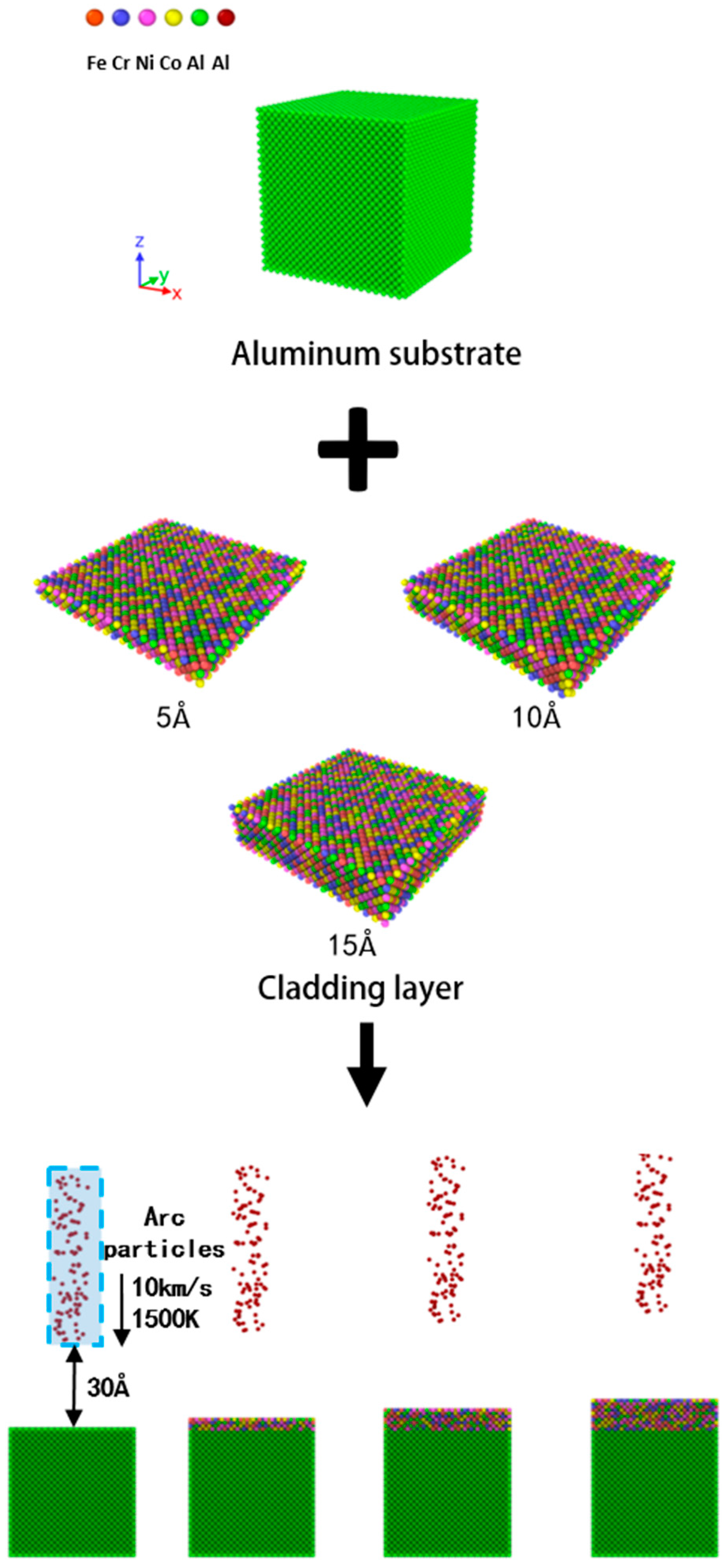
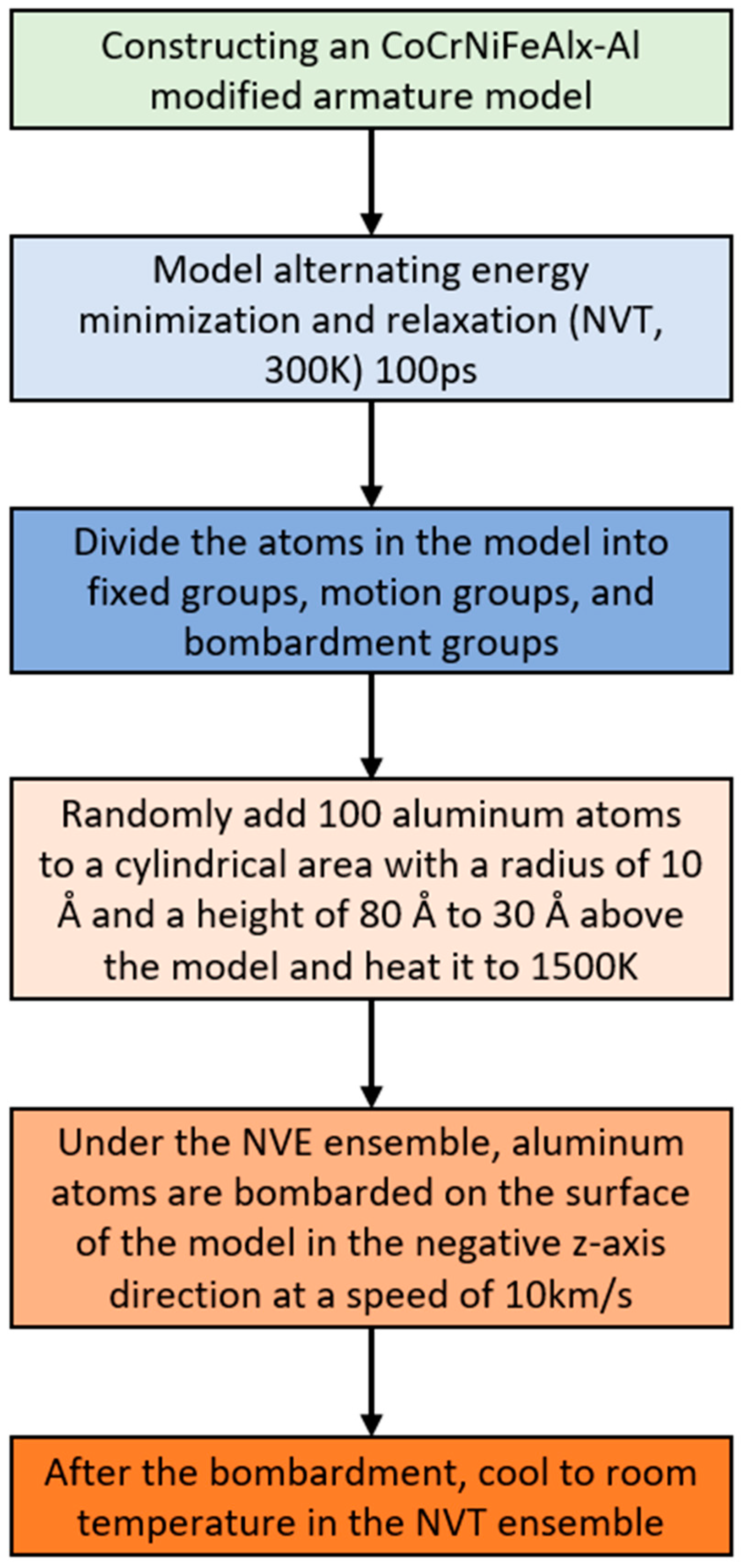

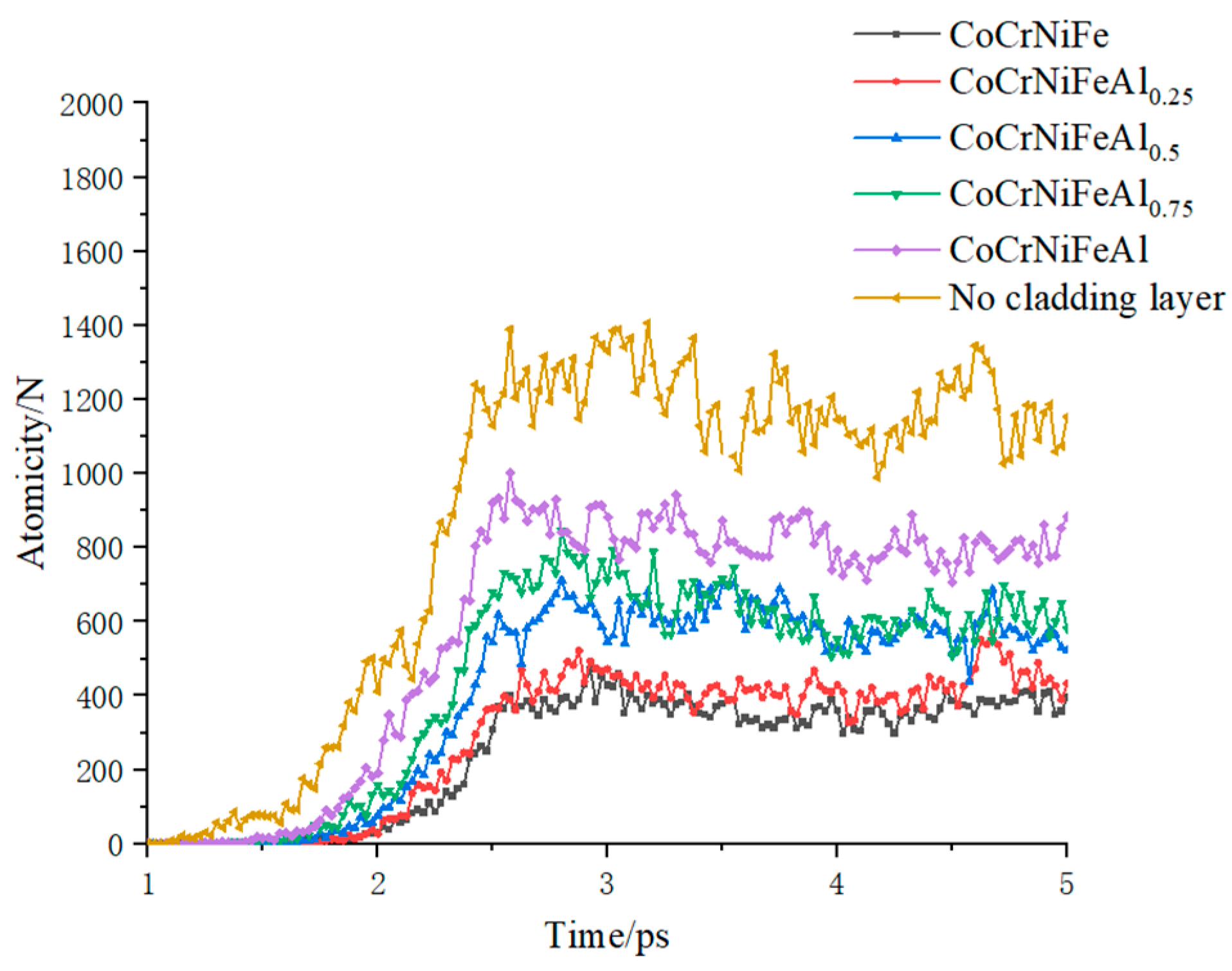
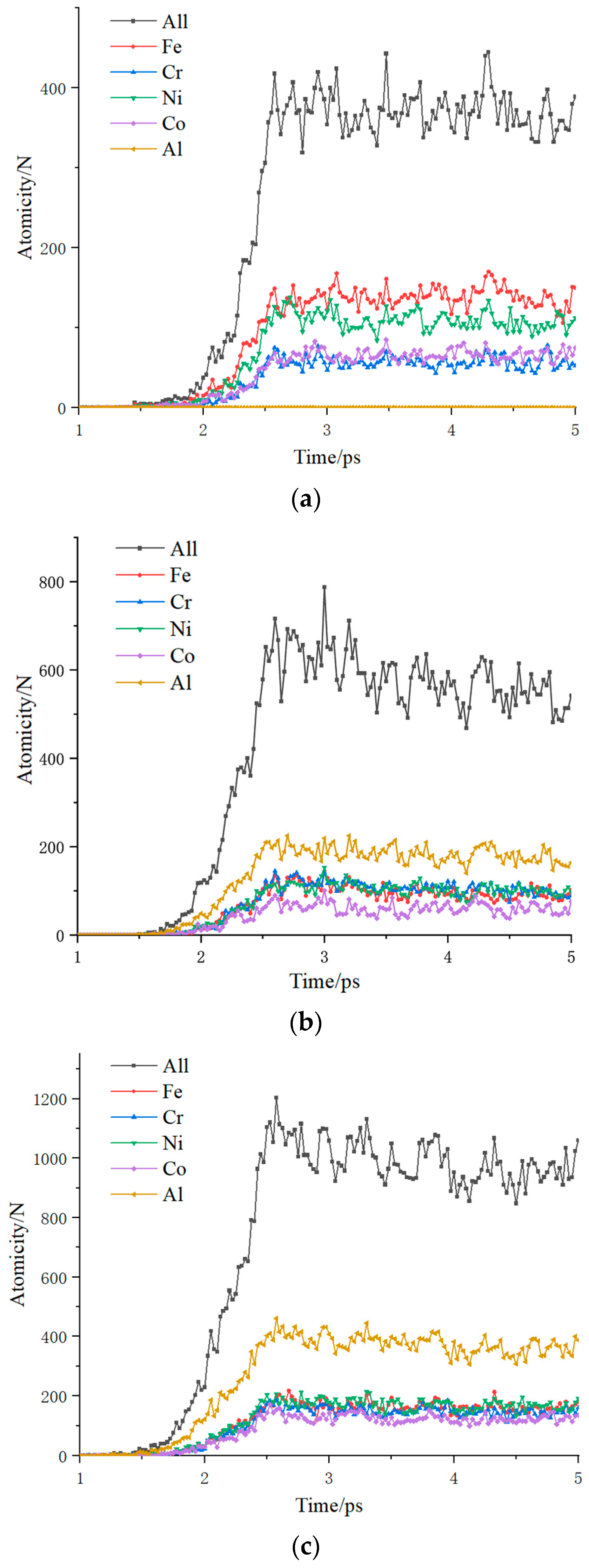

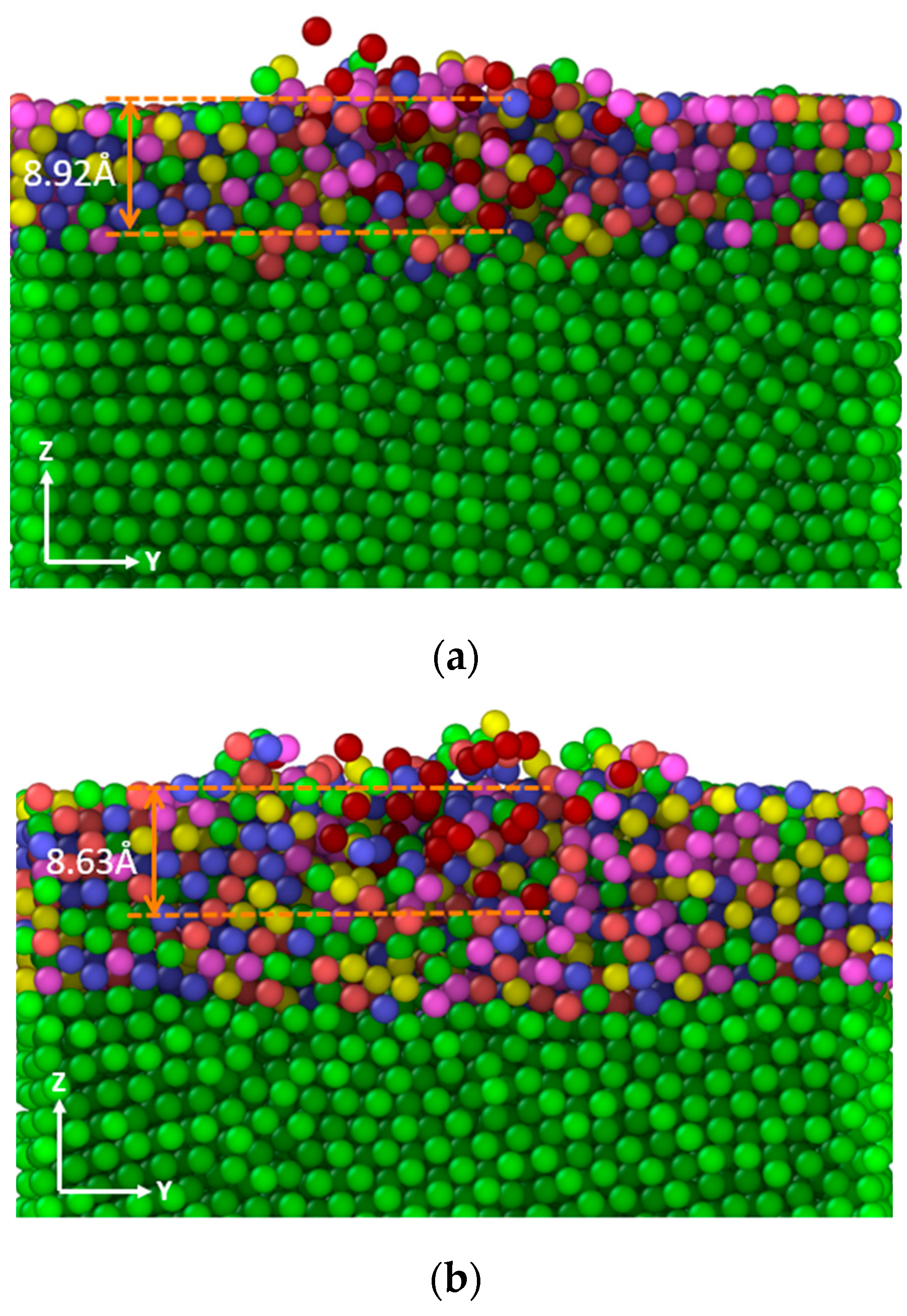


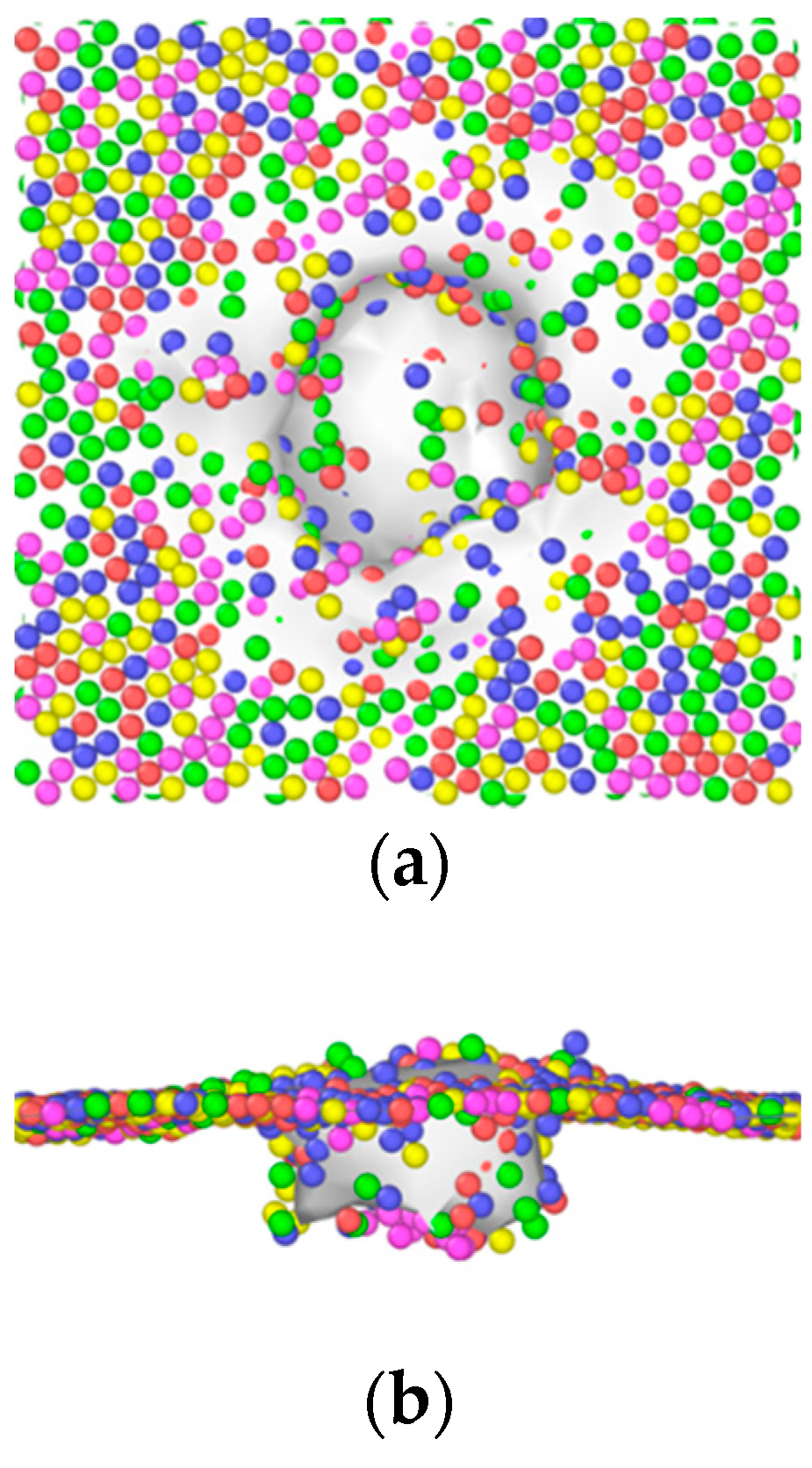

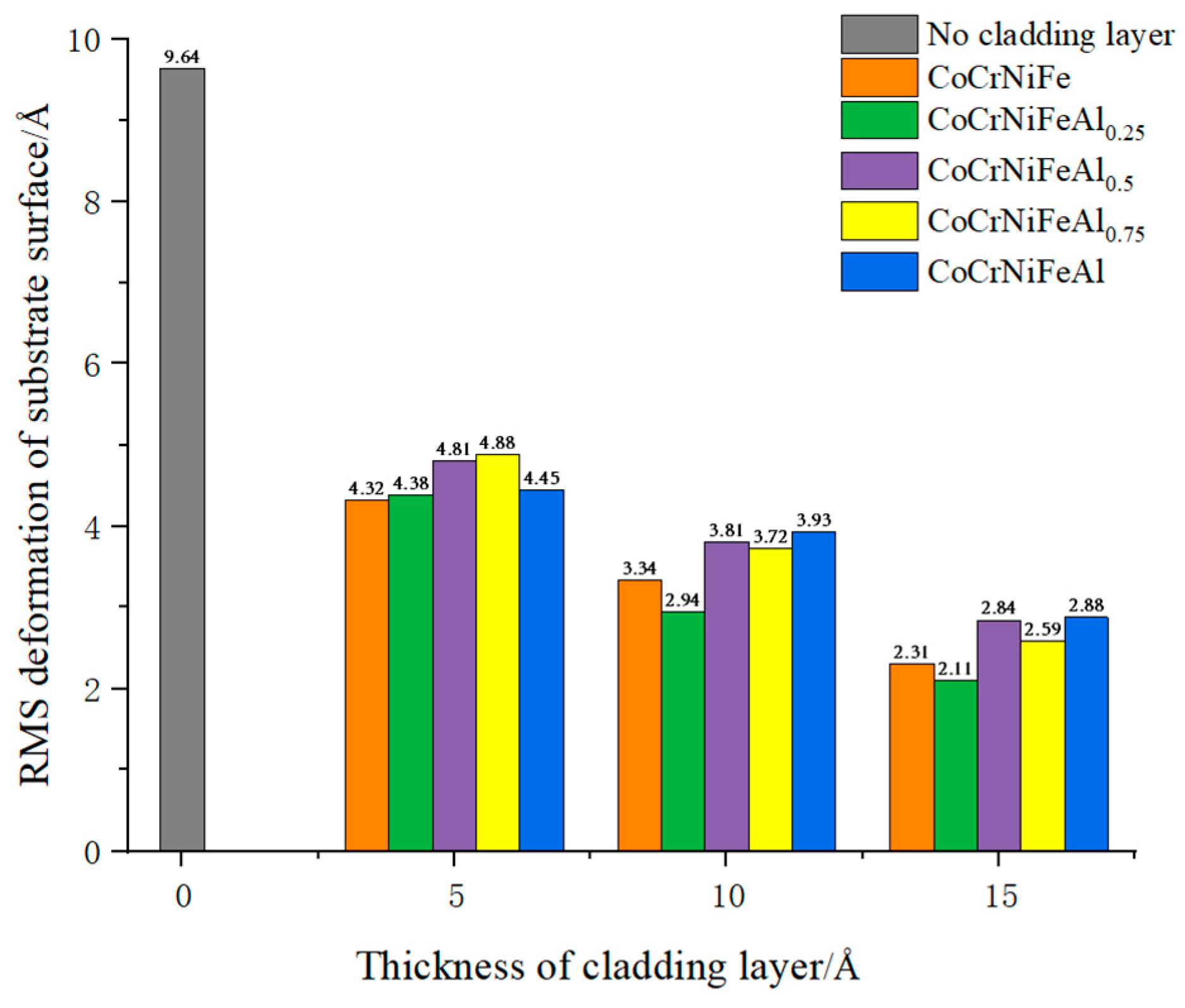
| Model | Peak Temperature/K |
|---|---|
| No cladding layer | 2024 |
| CoCrNiFe-Al | 1991 |
| CoCrNiFeAl0.25-Al | 2042 |
| CoCrNiFeAl0.5-Al | 2080 |
| CoCrNiFeAl0.75-Al | 2401 |
| CoCrNiFeAl-Al | 2147 |
| Thickness/Å | x | Depth/Å |
|---|---|---|
| 0 | / | 31.54 |
| 5 | 0.00 | 21.79 |
| 0.25 | 19.92 | |
| 0.50 | 18.25 | |
| 0.75 | 17.78 | |
| 1.00 | 18.08 | |
| 10 | 0.00 | 13.84 |
| 0.25 | 10.53 | |
| 0.50 | 9.92 | |
| 0.75 | 9.65 | |
| 1.00 | 8.92 | |
| 15 | 0.00 | 12.88 |
| 0.25 | 10.71 | |
| 0.50 | 9.37 | |
| 0.75 | 9.10 | |
| 1.00 | 8.63 |
Disclaimer/Publisher’s Note: The statements, opinions and data contained in all publications are solely those of the individual author(s) and contributor(s) and not of MDPI and/or the editor(s). MDPI and/or the editor(s) disclaim responsibility for any injury to people or property resulting from any ideas, methods, instructions or products referred to in the content. |
© 2024 by the authors. Licensee MDPI, Basel, Switzerland. This article is an open access article distributed under the terms and conditions of the Creative Commons Attribution (CC BY) license (https://creativecommons.org/licenses/by/4.0/).
Share and Cite
Teng, Y.; Zhang, L.; Wang, G.; Wu, M.; Fan, C.; Liu, S. Research on Arc Erosion Resistance of High-Entropy Alloy-Modified Aluminum Alloy Armature Based on Molecular Dynamics Simulation. Coatings 2024, 14, 187. https://doi.org/10.3390/coatings14020187
Teng Y, Zhang L, Wang G, Wu M, Fan C, Liu S. Research on Arc Erosion Resistance of High-Entropy Alloy-Modified Aluminum Alloy Armature Based on Molecular Dynamics Simulation. Coatings. 2024; 14(2):187. https://doi.org/10.3390/coatings14020187
Chicago/Turabian StyleTeng, Yuanxin, Li Zhang, Guan Wang, Meiying Wu, Chenlu Fan, and Shushuai Liu. 2024. "Research on Arc Erosion Resistance of High-Entropy Alloy-Modified Aluminum Alloy Armature Based on Molecular Dynamics Simulation" Coatings 14, no. 2: 187. https://doi.org/10.3390/coatings14020187
APA StyleTeng, Y., Zhang, L., Wang, G., Wu, M., Fan, C., & Liu, S. (2024). Research on Arc Erosion Resistance of High-Entropy Alloy-Modified Aluminum Alloy Armature Based on Molecular Dynamics Simulation. Coatings, 14(2), 187. https://doi.org/10.3390/coatings14020187





